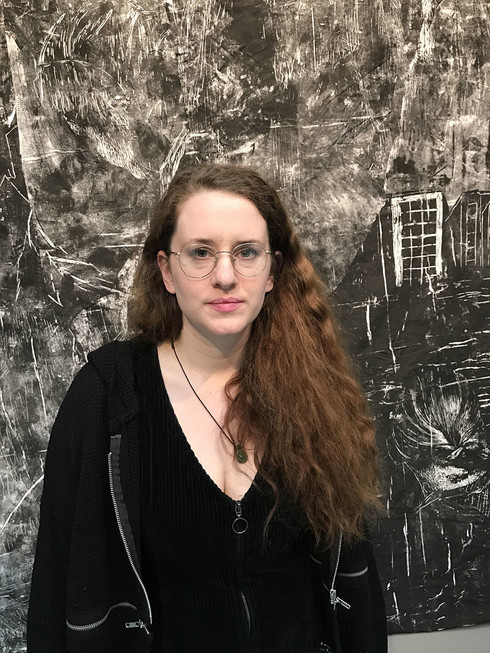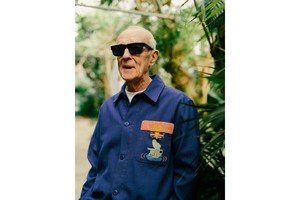Idun Baltzersen: She Explores the Boundaries Between Craft and Art
Written by Mari FlorerEdited by Marge Grossfeld.
The Norwegian artist Idun Baltzersen carves her drawings into plywood, which she then prints on textile sheets. The idea came to her during her master studies in art at Konstfack (University College of Art, Crafts and Design), when she found a corner with old building materials in the workshop.
Her motifs are independent teenage girls who turn their backs to the viewer. Idun Baltzersen is especially inspired by high school movies and the cult around them.
I meet Baltzersen at Konstakademin (The Royal Academy of Fine Arts) in Stockholm, where she shows me her ongoing exhibition “Övergångsriter” (Transition rites).
She comes straight from her atelier when I meet her in one of the exhibition halls. She tells me that she has been sketching all day for the forthcoming exhibition “Dialogue in drawing”, at Uppsala Art Museum beginning May 27th.
– It will be an installation of quick drawings, I have just started so I can’t say more.
She is happy about working in a smaller format this time. Her eyes get so tired of all the detail work when she works in large sizes and her hands hurt a lot.
– I think it was hard when I created my big work on the wall there.
She points to her grandiose textile collage that requires the entire wall surface in the gallery. I ask how she technically made that work.
– I carve each drawing individually in factory-format plywood boards. Then I print these on textiles, one by one. All the prints I sew together into an enormous sheet of fabric.
This is done with an obvious finish and I ask her how important the aesthetics are to her. She explains that she likes spontaneity but in controlled forms. She knows what feeling she seeks from the start.
She says she likes portraying young independent women, but I think I see a guy in the collage in front of me.
Who is that? I ask and point at him.
– Oh, that's my man, she says. He is also an artist.
Did you two meet each other at Konstfack?
– No, actually online, she replies. Tinder.
All her works are not black and white. When we walk through the exhibition room, she shows me some older work with colors, they are not as dramatic as the other ones. I see horse girls and I ask if she used to ride when she was a teenager. She explains that her sister did and that she has been watching her many times.
To what degree do you plan your artwork?
IB: I plan the individual parts quite carefully, but when I put together all the different figures, it can be very spontaneous.
Have you been practicing woodcutting for a long time?
IB: No, not actually, I was sketching before. A few years ago when I wanted to work in a larger format I discovered that when I went up in size, it became very difficult with the paper because it broke down. Then I found a plywood board, and it felt more natural to carve in it than to draw on it. The idea came very naturally to me - I already had the technical skills, with a Bachelor degree in Printmaking from Bergen, in Norway.
How do you decide the titles of your work?
IB: I try to find something that describes my thoughts about the work, but I'm not good at titles actually. I find one that I like and then I do ten versions of it. I am often inspired by individual words from poetry or Norwegian pop music. I like a pop singer called Kaja Gunnufsen very much.
You are fascinated by young women, heroines and martyrs. Have you read many such books?
IB: Yes, these stories are everywhere. Everyone has to go through the teen years, there is something that affects everyone and there is so much fun around it too. I like to watch high school movies, I think the stories are exciting. In my art I make my own addition to that cult; I make the teenage girls more monumental and authoritarian.
What High School movie do you like the most?
IB: I especially like one called “Heaters” (1988).
How much of you is in your art?
IB: A lot. I relate to all of this even though I'm outside the teenage years now. It was a defining period for me as a human being and there are flashbacks in my own life that I experience as exciting.
My own craftsmanship is also a very central part of my work. I want to do everything myself. That’s really important to me.
Why is that?
IB: It's all about presence. That everything is handmade and that there are different materials that do not necessarily come from a traditional art store, but rather from construction stores and IKEA, which I then process in different ways.
You participated in the Market Art Fair 2017. Did you sell anything?
IB: I did. I exhibited four works, of which three were sold to three private collectors. I sold the pieces that were a bit smaller. Not my biggest one.
Can you survive on your art?
IB: Yes, I get scholarships – mostly Norwegian ones. There are many scholarships available in Norway.
I received a Swedish scholarship from Konstakademin including this exhibition and a studio for one year. But now it's about to end. Fortunately, I have found a new studio.
Do you see any trends in the art world today?
IB: I notice that there are many more craftsmen - that's a huge difference. When I studied graphics it was a part of the department of artisan crafts with textiles and ceramics. Then you noticed that there was a little lower status compared to those who were doing “free art”. Now, it has really changed. There are a lot of ceramics that you can see in exhibitions today.
How many artists have studios here at Konstakademin?
IB: Not many. I share one with Anna-Karin Rasmusson and then Helene Billgren has a studio here too. But otherwise I do not meet so many other artists.
It's Friday afternoon and we do not see any people at all. I don’t have the conscience to use her time any longer. I say that I love to see her atelier before I go and nice as she is she invites me up.
In the corridor we pass a skylift. She says she will get her own skylift driver's license as soon as possible. She wants to be able to put up her large work herself whenever she wants to.
You don’t like being depended on others?
IB: Nope.














